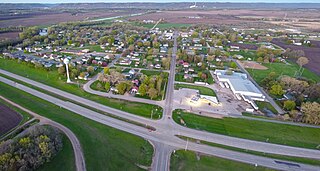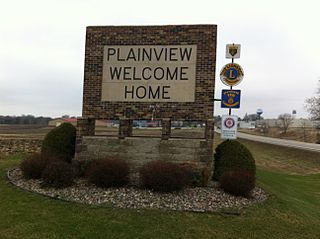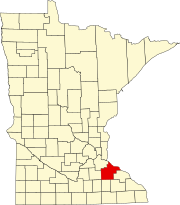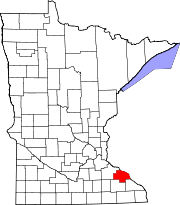
Wabasha County is a county in the U.S. state of Minnesota. As of the 2020 census, the population was 21,387. Its county seat is Wabasha.

Rowley is a city in Buchanan County, Iowa, United States. The population was 270 at the time of the 2020 census.

Elgin is a city in Wabasha County, Minnesota, United States on Minnesota State Highway 42. The population was 1,089 at the 2010 census. Its annual festival is Elgin Cheese Days.
Elgin Township is a township in Wabasha County, Minnesota, United States. The population was 787 at the 2000 census.
Gillford Township is a township in Wabasha County, Minnesota, United States. The population was 507 at the 2020 census. The unincorporated community of Oak Center is located in the township.
Greenfield Township is a township in Wabasha County, Minnesota, United States. The population was 1,254 at the 2000 census.

Hammond is a city in Wabasha County, Minnesota, United States. The population was 132 at the 2010 census.
Highland Township is a township in Wabasha County, Minnesota, United States. The population was 471 at the 2000 census.
Hyde Park Township is a township in Wabasha County, Minnesota, United States. The population was 275 at the 2000 census.

Kellogg is a city in Wabasha County, Minnesota, along the Zumbro River. The population was 456 at the 2010 census.
Lake Township is a township in Wabasha County, Minnesota, United States. The population was 412 at the 2000 census.

Millville is a city along the Zumbro River in Wabasha County, Minnesota, United States. The population was 182 at the 2010 census.

Plainview is a city in Wabasha County, Minnesota, United States. The population was 3,483 at the 2020 census, up from 3,340 at the 2010 census. The author Jon Hassler was raised in Plainview and some of the places in his writing are based on the town.

Wabasha is a city and the county seat of Wabasha County, Minnesota, United States. The population was 2,559 at the time of the 2020 census. It is on the Mississippi River, near its confluence with the Zumbro River.
West Albany Township is a township in Wabasha County, Minnesota, United States. The population was 439 at the 2000 census.
Zumbro Township is a township in Wabasha County, Minnesota, United States. The population was 715 at the 2000 census. The unincorporated community of South Troy is in Zumbro Township.

Lake City is a city in Goodhue and Wabasha counties in the U.S. state of Minnesota. It lies along Lake Pepin, a wide portion of the Mississippi River. The population was 5,252 at the 2020 census. Most of Lake City is located within Wabasha County with only a small portion in Goodhue County. Lake City is part of the Rochester, Minnesota Metropolitan Statistical Area.

Minneiska is a city in Wabasha and Winona counties in the U.S. state of Minnesota. The population was 97 at the 2020 census.

Nelson is a village in Buffalo County in the U.S. state of Wisconsin. The population was 374 at the 2010 census. The village is surrounded by the Town of Nelson.

Nelson is a town in Buffalo County in the U.S. state of Wisconsin. The population was 571 at the 2010 census. The village of Nelson is located within the town. The unincorporated community of Misha Mokwa and railroad junction Trevino are located in the town. The unincorporated community of Urne is located partially in the town.














